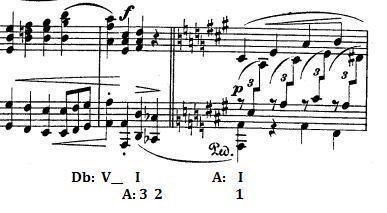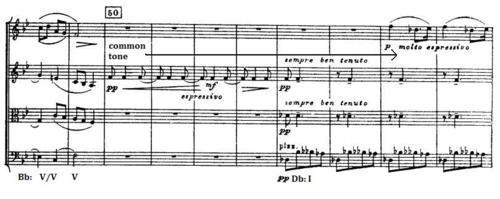-
Chromatic mediant relationships are relationships between two chords of the same quality whose roots are some type of third apart. The chromatic mediant became a common modulatory device in early Romantic harmony.
Those chords which have diatonic mediant relationships with C major are E minor at the 3rd above and A minor at the 3rd below. When we extend to allow for chromatic mediant relationships, we get the possibilities of E-flat major at the minor 3rd above and A major at the minor 3rd below, and E major at the at the major 3rd above and A-flat major at the major 3rd below. Each of these chromatic mediant possibilities shares one common tone with the C major triad and one chromatically altered tone of the C major triad (for instance, E-flat major shares G, the fifth of C major, and E-flat, the lowered third of C major).
One relatively early and surprising example of chromatic mediant modulation occurs in the transition from exposition to development in the first movement of Mozart’s Piano Sonata No. 17 in B-flat, K. 570:

This is a direct “phrase modulation,” making use of a beat’s pause and a repeated rhythmic gesture to move from F major to its chromatic mediant at the major third below, D-flat major, through the V7 chord in the new key.
In Schumann’s Novelette for piano, Op. 21, No. 1, an interesting chromatic mediant modulation through respelling occurs in transition to the second statement of the B theme:

Here, the key of A is really only a chromatic mediant of D-flat if the former is respelled as B-double flat. Schumann “steps down” into the key of A major via scale degrees 3 and 2 in B-double flat major, enharmonically respelling scale degree 1 into the new key of A at the new signature.
Chromatic mediant modulation by common tone is perhaps the most prevalent means, and was quite frequently used by Tchaikovsky, as in the well-known second movement of his String Quartet No. 1, Op. 11:

To transition into the inner section of the piece, the composer has taken advantage of the shared pitch F between the F and D-flat major triads; the root of F becomes the third of the new key, and is wisely reinforced here as the melodic center of the new theme.
Chromatic mediants are found in a number of jazz standards and popular songs, particularly in transitions from chorus to bridge and back again. Examples include the Beach Boys song “Wouldn’t It Be Nice?” and the Jerome Kern standard “Smoke Gets in Your Eyes.”
 mydruthersworld liked this
mydruthersworld liked this alma-mahler liked this
donovick reblogged this from leadingtone
callmeclarinet liked this
muzition liked this
downeydabs liked this
alittleurbanmusician liked this
musica-mundana-archived-blog liked this
currencyofleaves liked this
sugarplumthrussy liked this
gentle-giant-of-beasts liked this
piratejenne liked this
bringing-sexy-bach liked this
passionateprecipice liked this
2wire666 liked this
 youreacowboylikeme13 reblogged this from leadingtone
youreacowboylikeme13 reblogged this from leadingtone 12-tone reblogged this from leadingtone
12-tone liked this
compositiontheoryandarranging reblogged this from leadingtone
jros-blog liked this
nathanjohnson liked this
randallopry liked this
aaespo reblogged this from leadingtone
aaespo liked this
 fourthballade reblogged this from leadingtone
fourthballade reblogged this from leadingtone allacodetta liked this
lifeisonlyanostinato liked this
dichterliebe reblogged this from leadingtone
thestallsinourfarts liked this
modespirit liked this
blindedbyeverything-blog liked this
leadingtone posted this
Recent Post
Read more